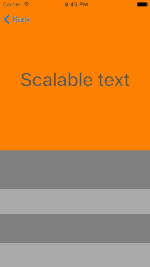/Pods/GSKStretchyHeaderView/README.md
https://gitlab.com/pqhuy1987/Mahaikum · Markdown · 115 lines · 83 code · 32 blank · 0 comment · 0 complexity · d82c5051f1a3e0c06679fb49d3668b22 MD5 · raw file
- # GSKStretchyHeaderView, by [gskbyte](https://twitter.com/gskbyte)
- [](http://cocoapods.org/pods/GSKStretchyHeaderView)
- [](http://cocoapods.org/pods/GSKStretchyHeaderView)
- [](https://github.com/Carthage/Carthage)
- [](http://cocoapods.org/pods/GSKStretchyHeaderView)
- [](https://travis-ci.org/gskbyte/GSKStretchyHeaderView)
- [](https://coveralls.io/github/gskbyte/GSKStretchyHeaderView)
- 
- 
- 
- 
- 
- GSKStretchyHeaderView is an implementation of the stretchy header paradigm as seen on many apps, like Twitter, Spotify or airbnb. It's designed in order to accomplish the following requirements:
- - Compatibility with `UITableView` and `UICollectionView`
- - Data source and delegate independency: can be added to an existing view controller withouth interfering with your existing `delegate` or `dataSource`
- - Provide support for frame layout, auto layout and Interface Builder `.xib` files
- - No need to subclass a custom view controller or to use a custom `UICollectionViewLayout`
- - Simple usage: just implement your own subclass and add it to your `UIScrollView` subclass
- - Two expansion modes: the header view can grow only when the top of the scroll view is reached, or as soon as the user scrolls down.
- If you are using this library in your project, I would be more than glad to [know about it!](mailto:gskbyte@gmail.com)
- ## Usage
- To add a stretchy header to your table or collection view, you just have to do this:
- ```objc
- - (void)viewDidLoad {
- [super viewDidLoad];
- CGSize headerSize = CGSizeMake(self.tableView.frame.size.width, 200); // 200 will be the default height
- self.stretchyHeader = [[GSKStretchyHeaderViewSubclass alloc] initWithFrame:CGRectMake(0, 0, headerSize.width, headerSize.height)];
- self.stretchyHeader.delegate = self; // this is completely optional
- [self.tableView addSubview:self.stretchyHeader];
- }
- ```
- or
- ```objc
- - (void)viewDidLoad {
- [super viewDidLoad];
- NSArray<UIView *> *nibViews = [[NSBundle mainBundle] loadNibNamed:@"GSKTabsStretchyHeaderView"
- owner:self
- options:nil];
- self.stretchyHeaderView = nibViews.firstObject;
- [self.tableView addSubview:self.stretchyHeaderView];
- }
- ```
- ## Configuration
- You can change multiple parameters in your stretchy header view:
- ```objc
- // you can change wether it expands at the top or as soon as you scroll down
- headerView.expansionMode = GSKStretchyHeaderViewExpansionModeImmediate;
- // You can change the minimum and maximum content heights
- headerView.minimumContentHeight = 64; // you can replace the navigation bar with a stretchy header view
- headerView.maximumContentHeight = 280;
- // You can specify if the content expands when the table view bounces, and if it shrinks if contentView.height < maximumContentHeight. This is specially convenient if you use auto layout inside the stretchy header view
- headerView.contentShrinks = YES;
- headerView.contentExpands = NO; // useful if you want to display the refreshControl below the header view
- // You can specify wether the content view sticks to the top or the bottom of the header view if one of the previous properties is set to NO
- // In this case, when the user bounces the scrollView, the content will keep its height and will stick to the bottom of the header view
- headerView.contentAnchor = GSKStretchyHeaderViewContentAnchorBottom;
- ```
- ## Creating your stretchy header
- There are two ways to create your own stretchy header:
- - Create a stretchy header subclass and add subviews to its `contentView`. You can layout its subviews manipulating their frames or using Auto Layout (also works with [GranadaLayout](https://github.com/gskbyte/GranadaLayout) :trollface:).
- - Create an Interface Builder file and map it to your `GSKStretchyHeaderView` subclass. Subviews added to the stretchy header will be automatically moved to the content view, keeping their constraints. Remember to set the properties `maximumContentHeight` and `minimumContentHeight` in the attributes inspector (fourth tab on the right panel in Interface Builder).
- To modify the behaviour and layout of your stretchy header, just override the method `-didChangeStretchFactor:` in your subclass, where you can adjust it by using the `stretchFactor`. To get a more detailed description of the properties, please have a look at the source code. There are also a few usage examples in the example project. You can also take them as a reference for your own stretchy headers.
- ## Example project
- To run the example project, clone the repo and open the workspace file `GSKStretchyHeaderView.xcworkspace`.
- You can also use `pod try GSKStretchyHeaderView`.
- ## Installation
- GSKStretchyHeaderView is available through [CocoaPods](http://cocoapods.org). To install it, simply add the following line to your Podfile, [you can check the Example Podfile to see how it looks like](https://github.com/gskbyte/GSKStretchyHeaderView/blob/master/Example/Podfile):
- ```ruby
- pod "GSKStretchyHeaderView"
- ```
- GSKStretchyHeaderView is also available through [Carthage](). To install it, just add this line to your `Cartfile:
- ```
- github "gskbyte/GSKStretchyHeaderView"
- ```
- and run
- ```bash
- carthage update GSKStretchyHeaderView
- ```
- ## Author
- Jose Alcalá Correa, jose.alcala.correa@gmail.com
- ## License
- GSKStretchyHeaderView is available under the MIT license. See the LICENSE file for more info.
- ## [Changelog](https://github.com/gskbyte/GSKStretchyHeaderView/blob/master/CHANGELOG.md)